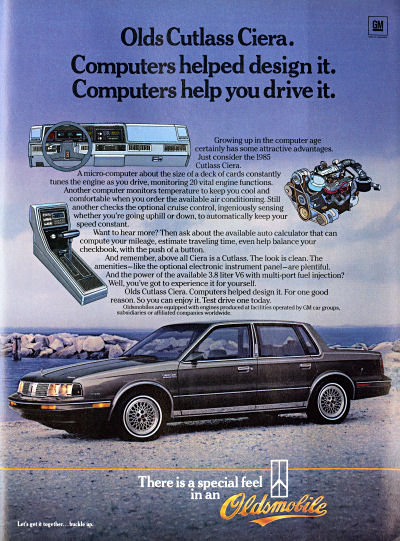[ Retro Scan ] The Promise and Peril of Computer-Cars
April 24th, 2017 by Benj Edwards Our 1984 model: Only 3,000 superfluous wheel spokes to clean
Our 1984 model: Only 3,000 superfluous wheel spokes to clean
Microprocessor technology hit the automotive world in a big way in the 1970s and 80s — car manufacturers began integrating microcontrollers into their products, and that move paid off with features like increased fuel efficiency, better cruise control, and more accurate climate control.
Some computer-related advantages in the automotive industry predated the invention of the microprocessor, however. In 1964, GM began using CAD software on IBM mainframes to help design the cars themselves. These computer design systems were some of the earliest to allow the manipulation of 3D models and the use of light pens for designer input. Their invention pushed forward the state of the art and practically invented the concept of CAD itself.
By the 1980s, manufacturers were touting products replete with computer-related perks, as this 1984 Oldsmobile Cutlass Ciera ad shows very well. Olds even provided an option for an integrated push-button digital calculator that could “help balance your checkbook.”
I’ve transcribed the ad copy below so you can read it more easily.
Growing up in the computer age certainly has some attractive advantages. Just consider the 1985 Cutlass Ciera.
A micro-computer about the size of a deck of cards constantly tunes the engine as you drive, monitoring 20 vital engine functions.
Another computer monitors temperature to keep you cool and comfortable when you order the available air conditioning. Still another checks the optional cruise control, ingeniously sensing whether you’re going uphill or down, to automatically keep your speed constant.
Want to hear more? Then ask about the available auto calculator that can compute your mileage, estimate travel time, even help balance your checkbook, with the push of a button.
And remember, above all Ciera is a Cutlass. The look is clean. The amenities — like the optional electronic instrument panel — are plentiful. And the power of the available 3.8 liter V6 with multi-port fuel injection? Well, you’re got to experience it yourself.
Olds Cutlass Ciera. Computers helped design it. For one good reason. So you can enjoy it. Test drive one today.
And hey, don’t forget about the role computers have played in automotive navigational systems. Consider the Etak Navigator, for example, which introduced computer-assisted navigation to cars for the first time in 1985. (I wrote about Etak in detail for FastCompany in 2015.)
The Downside of Computerized Cars
Today, most cars have hundreds of integrated microcontrollers doing everything from controlling the exhaust to toggling the headlights. The software-run car has been an incredible innovation, but it also has some significant drawbacks.
This reliance on software brings in new opportunities — through DRM — to put up unreasonable restrictions for people trying to maintain or repair their own vehicles. DRM also keeps small auto shops from being able to repair cars without paying huge fees to car manufacturers for licenses of specialized equipment. That’s why the Right to Repair is so very important. I’ve written previously about other problems with DRM for The Atlantic.
It’s looking like cars will become entirely self-driving very soon; computers are now beginning to replace drivers themselves. This brings up all kinds of potential DRM and privacy issues — for example, will you ever be able to go anywhere in a self-driving car without a big computer database knowing about it?
Don’t get me wrong. I’m still excited about the potential of these exciting new technologies. I would love to have a car that drives itself. But with so many disruptive innovations in the car industry coming soon, we are going to have our hands full trying to sort them all out both legally and ethically.
Discussion Topic: What was the make and model of the first car you ever drove?






April 25th, 2017 at 2:25 pm
Funny, I owned a 1985 Olds Cutlass Ciera while I was a college student. Mine didn’t have the optional calculator, or digital dash, or V6 engine. It did have a radio that rarely worked (even after replacing it several times with units pulled from junkyards), an ignition module that had to be replaced about once per year, strange rust spots that grew in the middle of the rear quarter panels, and it never wanted to warm up inside or defog the windows. Once, it died as I was driving down the street because the coil lead fell off the distributor cap. It did always start and get me to work – no matter how cold the depths of a Minnesota winter.
I owned several different 1980’s GM cars. I don’t miss any of them.
April 25th, 2017 at 5:47 pm
This nostalgic memory has been brought to you by… well, somebody but it for certainly wasn’t GM : )
April 26th, 2017 at 9:01 am
The first car I ever drove regularly was a 1979 Mazda 626. Manual transmission, full of fun. I’m not sure how many computers were hidden away in that model, but I suspect not very many.
April 29th, 2017 at 4:32 pm
Drove a 1968 Cutlass Supreme with a 350 V8. Went in a straight line great, terrible at turning and stopping.
Gas pedal tied to carburetor throttle plate with a good old fashioned wire. It broke once, and my dad drove it to the service station by tying a piece of string to the throttle plate and working it with his hand, hanging his arm out the window. One of the moments that made me think my dad was the coolest guy on earth.
May 5th, 2017 at 4:11 pm
To me it looks like that electric cars – selfdriving or not – will become much more disposable than fossil-fueled ones.
At least the European car manufacturers are mostly still on testing grounds (regarding customer reaction/acceptance) but they seem to favor very high battery replacement costs. About $10,000 for a car that costs $30-40,000.
The lifespan of the battery will practically destroy the market for used cars above a certain age.
If you buy a new car all is well up to the point you decide to sell it. Then the projected lifespan of the battery (most manufacturers here offer a battery warranty of five to eight years…) factors heavily into the selling price.
An eight-year old car with a dead battery will be sold dead cheap (perhaps one tenth or less of the original price) – which is not always the case with todays fuel guzzlers. Most cars that old today in good condition sell for about 20 to 30% of their original price.
And this is not even taking into account the advances in electronics/computing (self-driving etc.) that happen right now with breakneck speed.
In the end cars will be even more disposable than typical electronic goods (computers, TV sets etc.) because of these maintenance costs.
And, finally, it will accelerate the cost for electric power even quicker than in the last ten years.
May 15th, 2017 at 7:45 am
1981 Buick Century. It was more rust than steel by the end. I finally got rid of it when I realized that I didn’t feel with my family ridding in the back.
Thinking back, I’m starting to realize how spoiled we are by modern cars. I certainly share the concern about DRM and the inability to service your equipment, but the level of service required on modern cars totally different than what was needed in the 70’s and 80’s.
In the 80’s our family had a separate savings fund for car maintenance that seemed to be required monthly.
May 15th, 2017 at 9:55 am
Yep, that’s a great point, Geoff. Older cars were a lot of trouble to maintain. It is amazing how long you can go without major problems in cars these days.
November 4th, 2018 at 11:45 am
I could imagine governments making despotic use of computer-controlled technology, like the social credit system in China that is beginning to limit some people’s use of buses and airplanes. A car that knows your social credit could also restrict you from attending political events, government centers, or other places. For instance, if you have a restraining order against you from seeing your child, a smart car may not allow you to drive near to where the child is, even if your intention wasn’t to see the child but shop somewhere nearby.